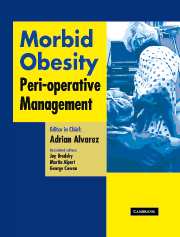Book contents
- Frontmatter
- Contents
- Contributors
- Foreword
- Preface
- Acknowledgments
- Dedication
- Section 1 General aspects
- Section 2 Pathophysiology
- Section 3 Pre-operative management
- Section 4 Peri-operative management of co-morbidities
- Section 5 Pharmacology
- Section 6 Monitoring
- Section 7 Intra-operative management
- Section 8 Post-operative care
- 25 Post-anesthetic care unit management
- 26 Respiratory management
- 27 Management of the obese critically ill patient in intensive care unit
- 28 Nursing management
- 29 Post-operative analgesia
- Section 9 Conclusions
- Afterword
- Index
29 - Post-operative analgesia
from Section 8 - Post-operative care
Published online by Cambridge University Press: 17 August 2009
- Frontmatter
- Contents
- Contributors
- Foreword
- Preface
- Acknowledgments
- Dedication
- Section 1 General aspects
- Section 2 Pathophysiology
- Section 3 Pre-operative management
- Section 4 Peri-operative management of co-morbidities
- Section 5 Pharmacology
- Section 6 Monitoring
- Section 7 Intra-operative management
- Section 8 Post-operative care
- 25 Post-anesthetic care unit management
- 26 Respiratory management
- 27 Management of the obese critically ill patient in intensive care unit
- 28 Nursing management
- 29 Post-operative analgesia
- Section 9 Conclusions
- Afterword
- Index
Summary
Introduction
As defined by the International Association for the Study of Pain (IASP), pain is recognized not only as a sensory experience but also as a phenomenon with affective and cognitive responses. An important aspect of pain is nociception, a complex series of electrochemical events that involves activation of specialized neural pathways in response to (potentially) tissue-damaging stimuli. Clinically, the degree of nociception is manifested as signs of tissue damage. Pain, in contrast to nociception, is a subjective experience that may involve stimulus-induced activation of afferent neural pathways or other components, such as somatosensory processing or psychosocial factors. Reflex responses to nociceptive stimulation can be described as suprasegmental or cortical and spinal or segmental. Spinal reflexes are generated by nociceptive signals being transmitted through the dorsal horn to somatomotor or autonomic neurons at various spinal levels, resulting in responses such as paralytic ileus, vasoconstriction, tachycardia, or muscle spasm. Suprasegmental reflexes are propagated via the ascending pathways to the brain stem, hypothalamus, and cortex, where withdrawal reflexes and autonomic responses are generated.
Acute pain results in various physiologic changes, such as the general stress response, that have significant effects on the respiratory, cardiovascular, gastrointestinal, genitourinary, and musculoskeletal systems.
Consequences of acute post-operative pain
General stress response
The stress response to surgical and other trauma results in endocrine and metabolic changes, such as increased secretion of catabolic hormones (for example, adrenocorticotropic hormone, antidiuretic hormone (ADH), and catecholamines) and decreased secretion of anabolic hormones (for example, insulin and testosterone).
- Type
- Chapter
- Information
- Morbid ObesityPeri-Operative Management, pp. 381 - 396Publisher: Cambridge University PressPrint publication year: 2004



